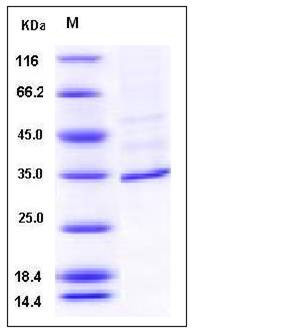Human FANCA / FACA Protein (His Tag)
FA,FA-H,FA1,FAA,FACA,FAH,FANCH
- 100ug (NPP2130) Please inquiry
| Catalog Number | P11980-H07B |
|---|---|
| Organism Species | Human |
| Host | Baculovirus-Insect Cells |
| Synonyms | FA,FA-H,FA1,FAA,FACA,FAH,FANCH |
| Molecular Weight | The recombinant human FANCA consists of 316 amino acids and predicts a molecular mass of 35.2 kDa. It migrates as an approximately 35 kDa band in SDS-PAGE under reducing conditions. |
| predicted N | Met |
| SDS-PAGE |  |
| Purity | > 85 % as determined by SDS-PAGE |
| Protein Construction | A DNA sequence encoding the human FANCA (AAH08979.1) (Met 1-Cys 297) was expressed, with a polyhistidine tag at the N-terminus. |
| Bio-activity | |
| Research Area | Cancer |Signal transduction |Other Related Intracellular Topics |DNA Damage and Repair |
| Formulation | Lyophilized from sterile 20mM Tris, 200mM NaCl, pH 8.5, 20% gly, 0.1% Triton, 1mM TCEP 1. Normally 5 % - 8 % trehalose and mannitol are added as protectants before lyophilization. Specific concentrations are included in the hardcopy of COA. |
| Background | FANCA is one of the six known Fanconi anemia gene products (FANCA, FANCC, FANCD2, FANCE, FANCF, and FANCG proteins). Fanconi anemia (FA) is a genetic disorder predisposing to aplastic anemia and cancer characterized by hypersensitivity to DNA-damaging agents and oxidative stress. FANCA associates with the IκB kinase (IKK) signalsome via interaction with IKK2. Components of the FANCA complex undergo rapid, stimulus-dependent changes in phosphorylation, which are blocked by kinase-inactive IKK2. |
| Reference |
